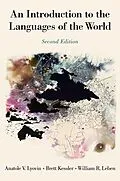Unique in scope, An Introduction to the Languages of the World introduces linguistics students to the variety of world's languages. Students will gain familiarity with concepts such as sound change, lexical borrowing, diglossia, and language diffusion, and the rich variety of linguistic structure in word order, morphological types, grammatical relations, gender, inflection, and derivation. It offers the opportunity to explore structures of varying and fascinating languages even with no prior acquaintance. A chapter is devoted to each of the world's continents, with in-depth analyses of representative languages of Europe, Asia, Africa, Oceania, and America, and separate chapters cover writing systems and pidgins and creoles. Each chapter contains exercises and recommendations for further reading. New to this edition are eleven original maps as well as sections on sign languages and language death and revitalization. For greater readability, basic language facts are now organized in tables, and language samples follow international standards for phonetic transcription and word-by-word glossing. There is an instructor's manual available for registered instructors on the book's companion website.
Autorentext
Anatole Lyovin is retired Associate Professor of Linguistics at the University of Hawaii at Manoa. Brett Kessler is Associate Professor Emeritus of Psychology at Washington University in St. Louis. William Leben is Professor Emeritus of Linguistics at Stanford University.
Zusammenfassung
Unique in scope, An Introduction to the Languages of the World introduces linguistics students to the variety of world's languages. Students will gain familiarity with concepts such as sound change, lexical borrowing, diglossia, and language diffusion, and the rich variety of linguistic structure in word order, morphological types, grammatical relations, gender, inflection, and derivation. It offers the opportunity to explore structures of varying and fascinating languages even with no prior acquaintance. A chapter is devoted to each of the world's continents, with in-depth analyses of representative languages of Europe, Asia, Africa, Oceania, and America, and separate chapters cover writing systems and pidgins and creoles. Each chapter contains exercises and recommendations for further reading. New to this edition are eleven original maps as well as sections on sign languages and language death and revitalization. For greater readability, basic language facts are now organized in tables, and language samples follow international standards for phonetic transcription and word-by-word glossing. There is an instructor's manual available for registered instructors on the book's companion website.
Inhalt
List of Tables List of Figures Symbols and Abbreviations 1 Classification of Languages 1.1 Genetic classification 1.2 Typological classification of languages 1.3 Exercises 1.4 Suggested readings 2 Classification of Writing Systems 2.1 Typological classification of writing systems 2.2 Genetic classification of writing systems 2.3 Exercises 2.4 Suggested readings 3 Europe 3.1 Indo-European 3.2 Uralic 3.3 Caucasus area 3.4 Basque 3.5 Sketch of Russian 3.6 Sketch of Finnish 3.7 Exercises 3.8 Suggested readings 4 Asia 4.1 Altaic area 4.2 Paleosiberian area 4.3 Sino-Tibetan 4.4 Hmong-Mien 4.5 Tai-Kadai 4.6 Austroasiatic 4.7 Dravidian 4.8 Burushaski 4.9 Other languages in Asia 4.10 Sketch of Mandarin Chinese 4.11 Sketch of Classical Tibetan 4.12 Exercises 4.13 Suggested readings 5 Africa 5.1 Afro-Asiatic 5.2 Nilo-Saharan 5.3 Niger-Congo 5.4 Khoisan area 5.5 Other languages in Africa 5.6 Sketch of Modern Standard Arabic 5.7 Sketch of Swahili 5.8 Exercises 5.9 Suggested readings 6 Oceania 6.1 Austronesian 6.2 Papuan area 6.3 Australian area 6.4 Sketch of Hawaiian 6.5 Sketch of Dyirbal 6.6 Exercises 6.7 Suggested readings 7 The Americas North American area 7.1 Eskimo-Aleut 7.2 Na-Dene 7.3 Algic 7.4 Muskogean 7.5 Siouan 7.6 Iroquoian 7.7 Caddoan 7.8 Yuman 7.9 Sahaptian 7.10 Tsimshianic 7.11 Kiowa-Tanoan 7.12 Uto-Aztecan 7.13 Salishan Mesoamerican area 7.14 Oto-Manguean 7.15 Totonacan 7.16 Mixe-Zoquean 7.17 Mayan South American area 7.18 Intermediate area 7.19 Western Amazonia 7.20 Northern foothills 7.21 Andes region 7.22 Southern foothills 7.23 South 7.24 Central Amazonia 7.25 Northern Amazonia 7.26 Sketch of Central Alaskan Yup?ik 7.27 Sketch of Ayacucho Quechua 7.28 Exercises 7.29 Suggested readings 8 Language Birth, Death, and Revitalization 8.1 Mixed languages 8.2 Constructed languages 8.3 Pidgins 8.4 Creoles 8.5 Sign languages 8.6 Language endangerment and renewal 8.7 Sketch of Tok Pisin 8.8 Exercises 8.9 Suggested readings References Language Index Subject Index
